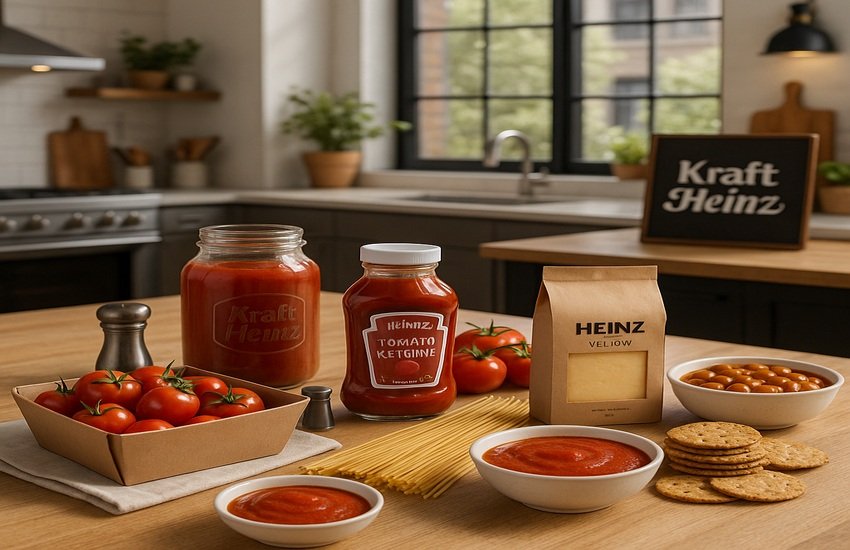Continue Reading With Our 7-Day Free Trial
In a dramatic turn of events, Kraft Heinz is preparing to split its business nearly a decade after one of the most storied mergers in consumer packaged goods history. The company plans to spin off a large chunk of its grocery portfolio — including iconic Kraft-branded products — into a standalone entity that could be valued at up to $20 billion. This move comes as Kraft Heinz struggles to regain momentum in a market rapidly shifting toward fresher, less processed, and more value-driven food choices. The announcement follows a string of portfolio reshuffles, including the sale of its infant and specialty-food business in Italy and recent guidance revisions driven by inflation, changing consumer behavior, and tariff uncertainty. Despite Berkshire Hathaway remaining a major shareholder, Warren Buffett has stepped away from board-level influence, and 3G Capital has fully exited its position. With brand renovation efforts in full swing and consumer tastes evolving faster than ever, the breakup underscores deeper structural issues that Kraft Heinz could no longer ignore.
The Merger’s Broken Promises & A Decade Of Decline
The 2015 Kraft-Heinz merger, orchestrated by Warren Buffett’s Berkshire Hathaway and private equity giant 3G Capital, was billed as a bold consolidation of two household food giants. At the time, the deal promised cost synergies, global scale, and brand power — but the combined company’s performance quickly faltered. Kraft Heinz’s zero-based budgeting approach, a hallmark of 3G’s strategy, led to aggressive cost-cutting that stripped critical investment from innovation, marketing, and brand equity. By 2019, the company was forced to write down the value of its Kraft and Oscar Mayer brands by $15 billion — a shocking public admission that these once-iconic assets had lost relevance. Sales stagnated, profitability dropped, and shareholder value eroded. Since the merger, the stock has plunged over 60%, erasing $57 billion in market cap. The company’s failure to adapt to changing consumer demands and an overreliance on legacy brands exposed deep cracks in its foundation. Meanwhile, competitors embraced better-for-you portfolios and digital transformation. Kraft Heinz’s inability to keep pace, despite occasional efforts at divestiture and innovation, left it increasingly bloated and unfocused. The recent strategic review and decision to split the company into more agile, focused units is a tacit acknowledgment that the promises of 2015 were never realized — and likely never would be without structural change.
A Tectonic Consumer Shift Toward Fresh, Natural & Value-Driven Brands
The food industry has undergone a radical transformation in recent years, driven by a seismic shift in consumer preferences toward healthier, more natural, and often more affordable products. Kraft Heinz’s traditional processed staples — like macaroni and cheese, mayonnaise, and packaged meats — have steadily fallen out of favor with both younger consumers and health-conscious families. The rise of private labels, plant-based alternatives, and DTC upstarts has intensified competition in a market that once prized legacy brands. Simultaneously, macroeconomic pressures such as inflation, SNAP benefit reductions, and the explosion of GLP-1 weight-loss drug usage have further eroded demand for calorie-dense processed foods. Even popular lines like Lunchables and Capri Sun faced image and quality perception challenges, prompting Kraft Heinz to scramble for reformulations and marketing resets. Carlos Abrams-Rivera, the company’s CEO, has acknowledged these headwinds and accelerated the rollout of its Brand Growth System (BGS) to better understand consumer expectations and update packaging, ingredients, and messaging accordingly. Yet these efforts, while commendable, may have come too late for parts of the business. As the company tries to reposition its ACCELERATE platforms like sauces, ready meals, and snacking for long-term growth, its traditional Kraft-branded grocery unit has become a strategic misfit. A separation allows each unit to pursue more targeted strategies, especially as consumers increasingly demand innovation, speed, and relevance — areas where Kraft Heinz, as a combined entity, has struggled to compete effectively.
Years Of Portfolio Pruning Signaled A Looming Structural Shift
Long before the breakup plans were made public, Kraft Heinz had been gradually divesting non-core or underperforming assets in an effort to sharpen its focus and improve shareholder returns. The most notable examples include the sale of the Planters nuts brand to Hormel in 2021 and the divestiture of its natural cheese business. More recently, the company sold its infant and specialty-food business in Italy, following a trend of offloading businesses with lower growth or strategic fit. While these sales helped raise capital and modestly improve margins, they also signaled a deeper internal recognition that Kraft Heinz could not thrive while trying to be everything to everyone. The growing emphasis on ACCELERATE platforms — such as taste elevation (sauces), ready meals (mac & cheese), and snacking (Lunchables) — further marginalized other segments of the portfolio, including legacy Kraft grocery brands. CFO Andre Maciel noted during multiple investor engagements that capital allocation would increasingly favor categories with strong tailwinds, margin profile, and innovation potential. The segmentation of the business into ACCELERATE, PROTECT, and BALANCE categories, while strategic, also laid the groundwork for separating those units operationally — a precursor to a full-scale breakup. For investors and analysts who’ve been following the story, this split isn’t a surprise. It’s the logical culmination of years of internal restructuring and market messaging — a move from portfolio tinkering to full-scale surgery.
Mounting External Pressures & Structural Challenges Accelerated The Timeline
Beyond internal missteps and shifting consumer tastes, Kraft Heinz has been contending with a rising tide of external challenges that made maintaining its conglomerate structure increasingly untenable. Inflationary pressures, particularly in commodities like coffee and meat, have pushed cost of goods sold higher, forcing the company to balance pricing decisions with the risk of alienating price-sensitive consumers. Tariff hikes, especially on goods imported from China, are expected to add another 150–200 basis points of inflation to 2025 costs, hitting product lines with global supply chains particularly hard. The company’s CFO has admitted that while they’ve hedged and pre-stocked inventory in some areas, the impact will be concentrated in the second half of the year — just as Kraft Heinz is ramping up its investment in brand renovation and sampling. Furthermore, regulatory pressures, including looming FDA restrictions on artificial colors and discussions around SNAP program changes, have added layers of operational complexity. While the company touts its 90% compliance with clean-label standards, adapting older legacy brands still requires significant R&D, packaging changes, and marketing overhaul. The wider operating income guidance for 2025 reflects this volatility, with leadership emphasizing flexibility and discipline in capital allocation. In this environment, separating the business into more focused, accountable entities may offer some insulation — or at least clarity — in responding to regulatory, economic, and competitive pressures that show no sign of easing.
Key Takeaways
The decision to break up Kraft Heinz marks a significant turning point for a company that once embodied the promise of scale and brand power in the packaged food industry. On one hand, the spin-off of its grocery unit could finally unshackle the faster-growing platforms like sauces, snacking, and ready meals, allowing them to attract capital, talent, and innovation at a pace more aligned with today’s consumer expectations. On the other, it raises questions about whether the newly separated Kraft-branded entity — largely centered around legacy processed food products — can find a meaningful growth narrative in an increasingly health-conscious, value-seeking world. While management’s tone has shifted to playing offense with discipline, much depends on execution, investor confidence, and how well each unit adapts post-split. For now, the breakup represents both an admission of past strategic miscalculations and a potential path toward greater operational focus — but whether it will lead to renewed relevance or simply delay further decline remains to be seen.





